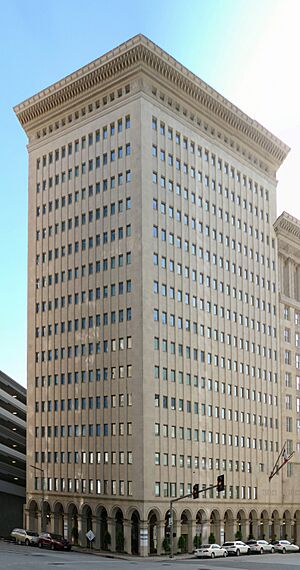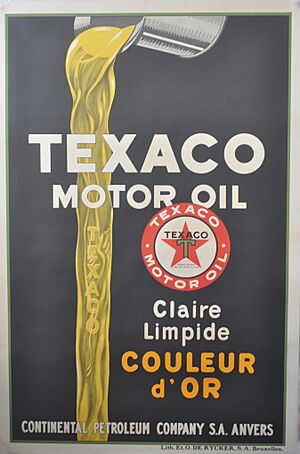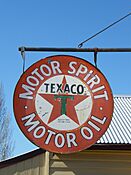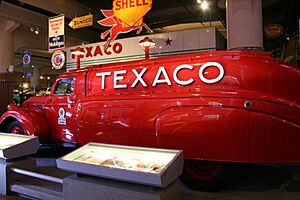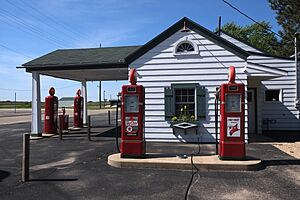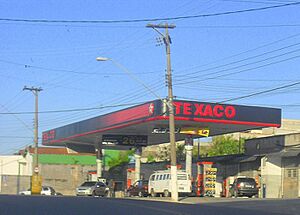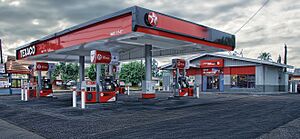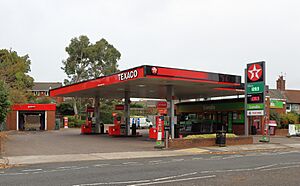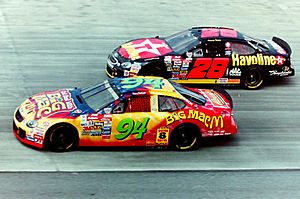Texaco facts for kids
 |
|
|
Formerly
|
|
|---|---|
|
|
| Industry | Petroleum |
| Fate | Acquired by Chevron Corporation in October 2001, changed to "ChevronTexaco" until 2005, when it became a brand of it |
| Founded | 1902 (as Texas Fuel Company) in Beaumont, Texas, U.S. |
| Founders | Joseph S. Cullinan Lewis Henry Lapham Arnold Schlaet |
| Headquarters | Texaco Headquarters, |
|
Number of locations
|
2,000+ (2006) |
|
Area served
|
Worldwide |
| Products | Gasoline, natural gas, motor oils, other petrochemicals |
| Brands | Havoline (1931–2001) |
| Owner | Chevron Corporation (2001–present) |
| Subsidiaries | Indian Oil Co. (1931–1943) |
Texaco, Inc. is an American oil company brand. It is currently owned and run by Chevron Corporation. Texaco is best known for its "Texaco with Techron" fuel. It also used to own the Havoline motor oil brand.
Texaco was an independent company for many years. Its oil refining parts joined with Chevron in 2001. After this, most of its gas stations were sold to Shell plc in the U.S.
The company started in 1902 in Beaumont, Texas. It was first called the "Texas Fuel Company." It was founded by Joseph S. Cullinan, Thomas J. Donoghue, and Arnold Schlaet. This happened after oil was found at a place called Spindletop.
The Texas Fuel Company was not set up to drill for oil. So, Joseph Cullinan started another company, Producers Oil Company, in 1902. Later, these two companies joined together to form Texaco.
Texaco was one of the "Seven Sisters." These were big oil companies that controlled the world's oil industry from the 1940s to the 1970s. Texaco's logo is a white star in a red circle. This star is a nod to the lone star of Texas. This led to famous advertising songs like "You can trust your car to the man who wears the star."
Today, Texaco gasoline includes Techron, a special additive. The Texaco brand is popular in the U.S., Latin America, and West Africa. It also has many gas stations in Europe, like in the UK.
Contents
Texaco's Journey: A Look at Its History
Early Days: How Texaco Began (1902–1938)
Texaco started as the "Texas Fuel Company" in Beaumont, Texas, in 1902. It was founded by Jim Hogg, Joseph S. Cullinan, John Warne Gates, and Arnold Schlaet. On May 1, 1902, the Texas Company was officially formed.
In 1905, Texaco started working in Antwerp, Belgium. By 1915, Texaco moved into a new, tall office building in Houston, Texas. In 1928, Texaco became the first U.S. oil company to sell its gasoline under one name across all 48 states at the time.
In 1931, Texaco bought the Indian Oil Company. This helped Texaco grow its business in the Midwest. It also gave Texaco the rights to Havoline motor oil, which became a Texaco product. The next year, Texaco introduced Fire Chief gasoline. This was a "super-octane" fuel. It was advertised on a radio show called Texaco Fire Chief.
In 1936, Texaco bought oil rights in Colombia. It worked with another company, Socony-Vacuum (now Mobil), to develop these oil fields. This was a very hard project. It involved drilling wells and building a pipeline across mountains and through jungles.
During this time, Texaco also sold oil to a group involved in the Spanish Civil War. This was against the rules at the time. Texaco was fined for this, but it continued to sell oil to that group.
Also in 1936, Texaco joined with Standard Oil Company of California (now Chevron). They formed a new company called Caltex. This company handled oil sales in Asia, East Africa, and Australia. The next year, Texaco hired a designer to create a modern look for its gas stations.
In 1938, Texaco launched Sky Chief gasoline. This was a high-quality fuel. In 1939, Texaco started a "Registered Rest Room" program. This made sure that restrooms at all Texaco stations were clean for travelers.
During World War II, Texaco's CEO, Torkild Rieber, had to leave his job. This was because of his connections to certain groups and his past oil sales during the Spanish Civil War.
In 1947, Caltex expanded to include Texaco's European sales. Texaco also took full control of its British company, Regent, in 1956. In 1954, Texaco added a cleaning additive called Petrox to its "Sky Chief" gasoline. This helped new cars with powerful engines run better.
In 1959, the Texas Company changed its name to Texaco, Inc. This was to show how important the Texaco brand name was. It was the best-selling gasoline brand in the U.S. and the only one sold under one name in all 50 states.
Growing and Changing (1964–1998)


In 1964, Texaco introduced a new design for its gas stations. Two years later, Texaco changed its famous banjo-shaped sign to a new hexagon logo. This new logo had a red outline with "TEXACO" in bold black letters. The Regent brand in Britain was also replaced by Texaco.
In 1970, Texaco introduced lead-free gasoline. This was because of new rules about car emissions. Lead-free Texaco became available across the country by 1974. In 1980, a big disaster happened at Lake Peigneur. Two years later, Texaco introduced a new gas station design. Some product names also changed. For example, Lead-free Texaco became Texaco Unleaded.
In 1985, Texaco faced a huge lawsuit. Another company, Pennzoil, won a $10.53 billion verdict against Texaco. This was because Texaco tried to buy Getty Oil after Pennzoil had already made a deal to buy it. In 1987, Texaco had to file for bankruptcy. This was the largest bankruptcy in U.S. history at that time.
In 1989, Texaco and Saudi Aramco formed a joint company called Star Enterprise. Saudi Aramco owned half of Texaco's refining and marketing in the eastern U.S. Texaco also introduced System3 gasolines. These fuels had new additives to help engines run better. The Texaco Canada company was sold to Imperial Oil.
In 1993, people from the Ecuadoran Amazon region filed a large lawsuit against Texaco. They said Texaco caused a lot of pollution in their area and rivers from its oil drilling. This led to toxic contamination for many residents.
In 1994, Texaco updated its System3 gasolines to new CleanSystem3 gasoline. In 1995, Texaco combined its operations in Denmark and Norway with Norsk Hydro. This created a new brand called HydroTexaco. In 1996, Texaco paid over $170 million to settle lawsuits about racial discrimination from its black employees. This was a very large settlement at the time.
Joining Chevron Corporation (1999–Present)
In 1999, Texaco teamed up with Shell Oil Company to form Equilon. This combined their oil refining and marketing in the Western and Midwestern U.S. Another joint company, Motiva Enterprises, was also formed with Shell and Saudi Aramco.
In October 2000, Chevron Corporation agreed to buy Texaco for $36 billion. The merger was finished on October 9, 2001. As part of the deal, Texaco's shares in Equilon and Motiva were sold to Shell. Shell then started changing its Texaco stations to Shell stations. In 2004, Chevron got the rights to use the Texaco brand name again in the U.S. The next year, Texaco added the Techron additive to its fuels in the U.S. and parts of Latin America.
Texaco's Main Offices
Before Texaco joined Chevron, its main office was a large building in Harrison, New York. This was near White Plains. In 2002, Chevron Corporation sold this former Texaco Headquarters building.
In the 1930s, Texaco also rented 14 floors of the Chrysler Building in Midtown Manhattan, New York City. As part of this deal, the building opened the Cloud Club, a special lunch club for executives. When Texaco moved its main office in 1977, the Cloud Club closed a few years later.
Texaco's Leaders
Texaco had many important leaders throughout its history. Here are some of the people who served as its President and Chairman of the Board:
Presidents
- Joseph S. Cullinan, 1901–1913
- Elgood C. Lufkin, 1913–1920
- Amos L. Beaty, 1920–1926
- William S. Rodgers, 1933–1944
- Harry T. Klein, 1944–1952
- Augustus C. Long, 1953–1956
- James W. Foley, 1956–1963
- John K. McKinley, 1971–1983
- Alfred C. DeCrane Jr, 1983–1986
- James W. Kinnear, 1987–1993
Chairmen of the Board
- Elgood C. Lufkin, 1920–1926
- Amos L. Beaty, 1926–1927
- Charles B. Ames, 1933–1935
- Torkild Rieber, 1935–1940
- William S. Rodgers, 1944–1953
- Augustus C. Long, 1956–1965
- Maurice F. Granville, 1971–1980
- John K. McKinley, 1980–1986
- Alfred C. DeCrane Jr, 1987–1996
- Peter I. Bijur, 1997–2001
- Glenn F. Tilton, 2001
Texaco's Sponsorships
Texaco has sponsored many sports and entertainment events.
Sports Sponsorships
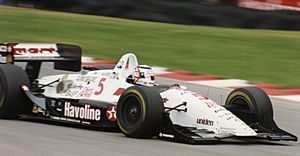

Texaco is linked to the Havoline brand of motor oil. It was a big sponsor of NASCAR racing. Many famous drivers, like Davey Allison and Dale Jarrett, raced with Havoline sponsorship. Texaco/Havoline stopped sponsoring NASCAR in 2008, ending a relationship that lasted over 20 years.
Texaco also sponsored open wheel racing. It sponsored the Texaco Grand Prix of Houston. It also sponsored drivers like Indianapolis 500 winner Mario Andretti and his son Michael.
In Formula One racing, Texaco sponsored Team Lotus in the early 1970s and McLaren from 1974 to 1978. The company returned to Grand Prix racing in 1997, sponsoring the Stewart team.
Texaco also sponsored touring car racing teams in Europe and Australia. For example, it sponsored the Ford Sierra RS500 cars in the 1987 World Touring Car Championship. In Australia, its brand Caltex was a major sponsor for Colin Bond Racing and Stone Brothers Racing.
From 1984 to 1998, Texaco was the main sponsor of a major cricket tournament in England, called the Texaco Trophy. It also sponsored the Texaco Cup, a football (soccer) tournament for clubs in the British Isles.
Entertainment Sponsorships
Texaco was famous for sponsoring the Metropolitan Opera radio broadcasts for 63 years. It was also known for sponsoring shows with stars like Ed Wynn, Fred Allen, and Milton Berle. Their shows were often called Texaco Star Theater.
In the 1930s, comedian Ed Wynn hosted a radio show called "The Texaco Fire Chief." Later, Milton Berle took over with the 60-minute Texaco Star Theater on TV.
Environmental Concerns
From 1965 to 1993, Texaco was part of a group that developed the Lago Agrio oil field in Ecuador. The company was accused of causing a lot of environmental damage from these operations. People and the government of Ecuador have filed lawsuits against Texaco. This case became well-known through a documentary film called Crude.
Texaco's current owner, Chevron, says that it is being unfairly targeted. They argue that the main responsibility for the pollution lies with the government and its national oil company, Petroecuador.
It was claimed that Texaco did not follow its usual drilling practices. Instead, it allegedly dumped dirty wastewater directly into rivers. It also supposedly put waste into unlined pits and created pits that had pipes leading to nearby waterways. These pits were also said to have never been emptied. It is estimated that over 18 billion gallons of toxic waste were released into the Amazon Rainforest. It was also claimed that workers burned off toxic gases and some liquid waste, which released harmful chemicals into the air.
New Technologies
The battery technology used in modern hybrid cars was invented by Stan Ovshinsky and Dr. Masahiko Oshitani. In 1994, General Motors bought a large share in Ovonic's battery development. In 2001, Texaco bought GM's share in this company. Six days later, Chevron bought Texaco. In 2003, the battery company was reorganized into Cobasys. This was a joint company between Chevron and Energy Conversion Devices (ECD) Ovonics.
See also
- Chevron Corporation - Texaco's parent company
- Caltex – a joint company between Texaco and Chevron, now a major international brand of Chevron Corporation
- Cobasys - a joint company between Chevron and Energy Conversion Devices, which makes power systems for cars


